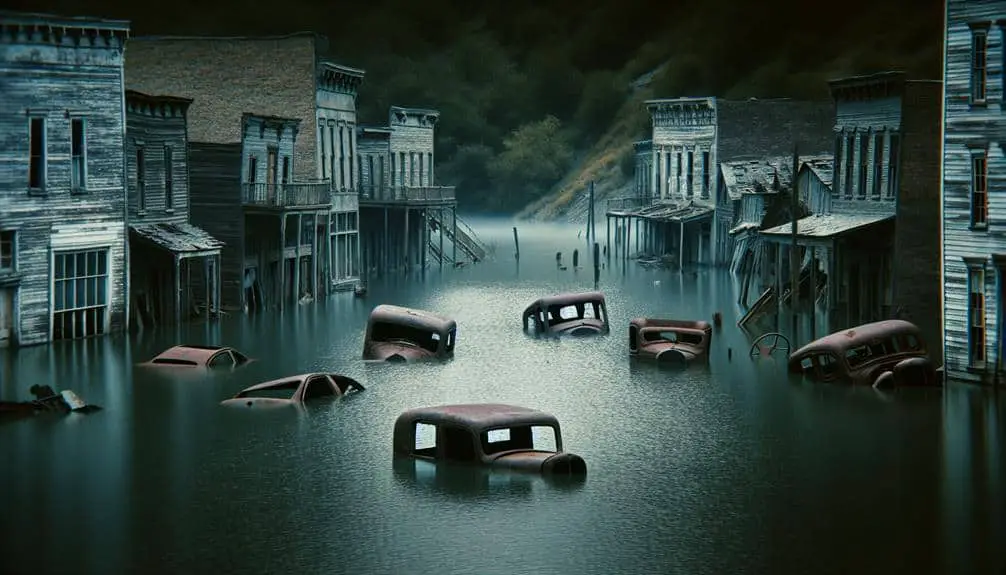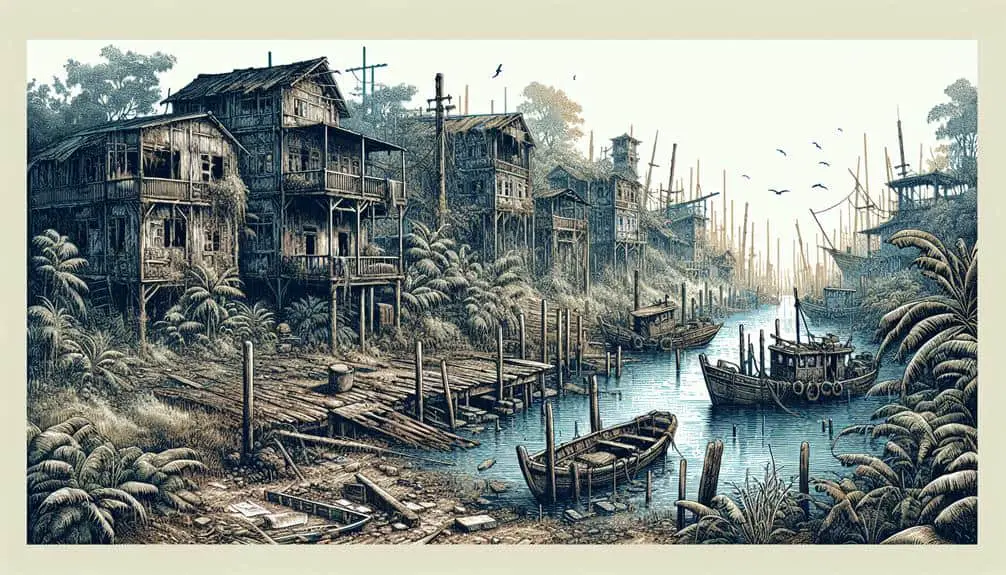If you've ever wondered why many US river ghost towns remain submerged, it's because of environmental consequences, human interventions like dam construction, and the resulting alterations in river flow. These factors have led to their submergence and preservation underwater. The impact of dams on river ghost towns includes disruptions to local ecosystems, missed opportunities for heritage tourism, and hindrance to archaeological exploration. However, preservation efforts utilizing advanced technologies, cultural heritage preservation, and environmental monitoring aim to conserve these submerged towns. Technological advancements and public interest might pave the way for lost towns to resurface with meticulous excavation and analysis of artifacts.
Key Points
- Submergence due to dam construction altering natural river flow.
- Erosion and sedimentation contribute to towns remaining underwater.
- Environmental consequences of human interventions like water diversion.
- Archeological exploration hindered by submergence of the towns.
- Vital to unravel mysteries behind submerged towns and preserve history.
Historical Background of US River Ghost Towns
In the exploration of the historical background of US river ghost towns, it's crucial to trace back the origins of these abandoned settlements to understand the factors that led to their submergence. These river towns, with their rich origins often tied to the early days of American settlement, hold significant cultural significance. Established along riverbanks for trade, transportation, or industry, these towns were bustling centers of activity. Their origins can be traced back to the expansion of railroads and the discovery of gold, leading to rapid growth and prosperity.
The cultural significance of these towns lies in their unique architecture, folklore, and the stories of the people who once inhabited them. Each town had its own character shaped by the industries and communities that thrived there. Understanding the origins of these river towns provides a glimpse into a bygone era, shedding light on the hopes, dreams, and struggles of the people who called them home. As we explore the historical background of US river ghost towns, we uncover a tapestry of American history woven with threads of triumph and tragedy.
Causes of Submergence in River Towns
Investigating the reasons behind the submergence of river towns exposes an intricate network of environmental, economic, and societal factors that played a role in their eventual disappearance beneath the waters. When looking at the causes of submergence in river towns, several key factors come into play:
- Environmental Consequences: Changes in river flow patterns due to natural causes like floods or droughts can lead to the submergence of towns over time.
- Erosion and Sedimentation: Increased erosion and sedimentation in rivers can alter the landscape, causing river towns to be slowly engulfed by water.
- Archeological Exploration: In some cases, submergence of river towns has led to the preservation of historical sites, attracting archeologists to study these submerged areas.
- Human Intervention: Activities such as dam construction or water diversion projects have had a significant impact on the submergence of river towns, altering the natural flow of rivers and leading to their disappearance beneath reservoirs.
Understanding these causes is vital in unraveling the mysteries behind the submerged river towns and their importance in history.
Impact of Dams on River Ghost Towns
The construction of dams along rivers has had a profound impact on the existence and preservation of river ghost towns. Dams alter the natural flow of rivers, leading to the flooding of valleys where these towns once thrived. The environmental consequences are significant, as the submerged areas can disrupt local ecosystems and water quality. Economically, the loss of these towns means missed opportunities for heritage tourism and related industries that could have benefited from their historical significance.
In terms of cultural significance, the submergence of these towns erases tangible links to the past, impacting the collective memory of a region. The potential for archaeological exploration is hindered by the underwater conditions created by damming, making it challenging to study and preserve these sites effectively. Understanding the impacts of dams on river ghost towns is important for evaluating the trade-offs between development and the preservation of historical and environmental heritage.
Preservation Efforts for Sunken Towns
As we consider the preservation efforts for sunken towns, the focus shifts towards innovative strategies aimed at safeguarding these submerged historical sites from further deterioration and loss. Underwater archaeology plays an important role in unraveling the mysteries hidden beneath the waters.
To guarantee the protection and conservation of these submerged ghost towns, various initiatives are being undertaken:
- Advanced Technologies: Cutting-edge equipment like underwater drones and 3D mapping technologies are employed to survey and document the sunken towns accurately.
- Cultural Heritage Preservation: Collaborations between archaeologists, historians, and local communities are fostered to preserve the cultural significance of these submerged sites.
- Environmental Monitoring: Constant monitoring of the underwater environment is essential to assess any threats posed by natural elements or human activities.
- Public Awareness Campaigns: Educating the public about the importance of these sunken towns in American history fosters a sense of responsibility towards their preservation.
Through a combination of technological innovation, cultural appreciation, environmental vigilance, and community involvement, efforts in underwater archaeology continue to contribute significantly to the preservation of submerged ghost towns and their cultural heritage.
Future Prospects for Resurfacing Ghost Towns
Exploring the potential for resurfacing ghost towns involves evaluating historical significance, technological advancements, and practical feasibility. Underwater archaeology plays an important role in uncovering the secrets hidden beneath the waters. Through meticulous excavation and analysis of artifacts, researchers can piece together the past lives of these submerged communities, shedding light on their cultural and economic contributions.
Urban exploration enthusiasts are drawn to the allure of these underwater ghost towns, keen to witness firsthand the remnants of a bygone era. As technology continues to advance, underwater drones and remotely operated vehicles are making it easier to navigate and document these submerged sites. These tools not only aid in exploration but also contribute to the preservation of these delicate historical locations.
The future prospects for resurfacing ghost towns depend on a delicate balance of conservation efforts and public interest. By leveraging technological innovations and fostering a deeper appreciation for our submerged history, there's a possibility for these lost towns to resurface, allowing us to connect with our past in a truly immersive way.
Frequently Asked Questions
How Do Underwater Ghost Towns Affect Local Wildlife and Ecosystems?
Underwater ghost towns can severely impact habitats and disrupt the ecological balance of local wildlife. The presence of these submerged structures alters the natural environment, affecting the flora and fauna that rely on undisturbed ecosystems.
Are There Any Myths or Legends Surrounding the Submerged Ghost Towns?
Ever heard the spooky tales of towns lost beneath the waters? Enigmatic stories, folklore, and mysterious disappearances shroud these submerged places in legends. Plunge into the depths of history where reality and myth intertwine.
Have There Been Any Notable Archaeological Discoveries in the Sunken River Towns?
Exploration findings in sunken river towns have exposed a treasure trove of historical artifacts. Notable discoveries include ancient tools, pottery, and remnants of daily life. These excavations shed light on the past civilizations that once flourished underwater.
What Role Do Underwater Ghost Towns Play in Local Tourism and Economy?
In local tourism and economy, underwater ghost towns serve as historical preservation sites, preserving cultural significance. They attract visitors, boosting economic impact through tourism. The allure of exploring submerged relics adds a unique charm to these destinations.
River dredging is essential for navigation but can impact historical preservation of underwater ghost towns. Balancing infrastructure needs and historical significance is critical. Careful planning guarantees both efficient navigation and preservation of valuable historical sites.



